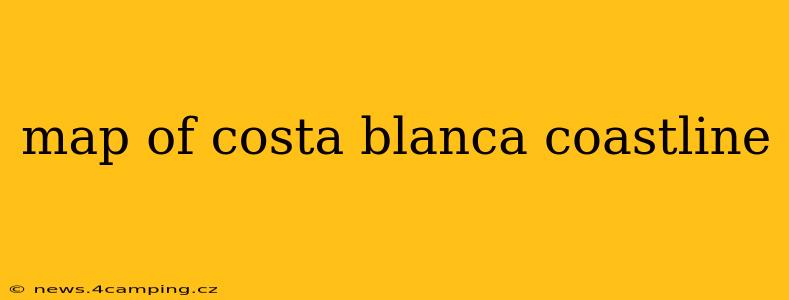The Costa Blanca, meaning "White Coast" in Spanish, stretches along the Mediterranean Sea in southeastern Spain. Famous for its stunning beaches, charming towns, and vibrant culture, it's a popular destination for tourists and expats alike. This guide will provide you with a detailed look at the Costa Blanca coastline, using maps and information to help you plan your perfect trip.
What is the Costa Blanca Coastline?
The Costa Blanca encompasses approximately 200km of coastline, boasting a diverse landscape of golden sandy beaches, rugged cliffs, hidden coves, and picturesque towns. Its unique beauty stems from a combination of natural wonders and historical significance. The region's mild climate, averaging around 20°C (68°F) year-round, adds to its allure, making it a desirable location for both summer holidays and winter sun escapes.
A Visual Journey: Exploring the Costa Blanca Map
While a single map can't capture the entire essence of the Costa Blanca, it's an essential tool for planning your itinerary. You'll find numerous detailed maps online, including interactive ones offering street-level views and points of interest. These maps typically highlight major cities, towns, beaches, and attractions. Look for maps that allow you to zoom in and out, enabling you to explore specific areas in detail.
Consider searching for "Costa Blanca detailed map" or "Costa Blanca tourist map" on your preferred search engine or map application (such as Google Maps). These searches will yield various map options, including those showing hiking trails, cycling routes, or specific points of interest relevant to your travel style.
Key Towns and Cities Along the Costa Blanca Coastline:
The Costa Blanca isn't just one long beach; it’s a collection of diverse towns and cities, each offering its unique charm:
- Alicante: The largest city, boasting a bustling port, historic castle (Santa Bárbara Castle), and vibrant nightlife.
- Benidorm: Known for its high-rise hotels, lively atmosphere, and stunning beaches.
- Calpe: Famous for its iconic Peñón de Ifach rock, beautiful beaches, and relaxed atmosphere.
- Altea: A charming town characterized by its whitewashed houses, cobbled streets, and stunning views.
- Jávea/Xàbia: Offers a mix of stunning beaches, coves, and a more tranquil atmosphere than Benidorm.
- Denia: A historic port city with a long sandy beach and a lively marina.
What are the best beaches on the Costa Blanca?
The Costa Blanca boasts a wide variety of beaches, catering to different preferences. Some popular choices include:
- Playa de Levante (Benidorm): A wide, sandy beach perfect for families.
- Playa de la Fossa (Calpe): A long, sandy beach close to the Peñón de Ifach.
- Granadella Cove (Jávea): A picturesque cove with crystal-clear waters.
- Arenal Beach (Jávea): A wide, sandy beach with a lively atmosphere.
- San Juan Beach (Alicante): A long, sandy beach with plenty of amenities.
What is the best time to visit the Costa Blanca?
The best time to visit the Costa Blanca depends on your preferences. Spring (April-May) and autumn (September-October) offer pleasant temperatures, fewer crowds, and lower prices. Summer (June-August) is the warmest and busiest time, ideal for swimming and sunbathing. Winter (November-March) is mild but can be rainy at times.
How can I get around the Costa Blanca?
Getting around the Costa Blanca is relatively easy. You can rent a car for maximum flexibility, use public transport (buses are readily available), or take taxis. Many towns and cities are also easily walkable.
This comprehensive guide offers a starting point for exploring the captivating Costa Blanca coastline. Remember to consult detailed maps and tailor your itinerary based on your interests and preferences. Enjoy your journey!
